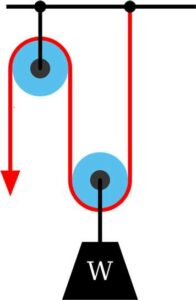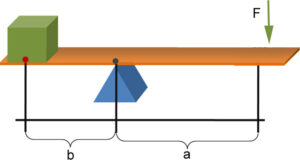Mechanical Aptitude Practice Questions
- Posted by Brian Stocker MA
- Date May 20, 2014
- Comments 5 comments
Simple Machines – Gears, Pulleys and Levers
Mechanical aptitude questions are found on the Canadian Firefighter and Elevator Industry Aptitude tests. Other occupations are, Automotive and Aircraft Mechanics, Engineers, Installation and Maintenance Repair people, Industrial and Technical (Non-Retail) Sales Representatives, and Skilled Tradespeople such as Electricians, Welders, and Carpenters Transportation Trades and Equipment Operators such as Truck drivers and Heavy Equipment Operators. Mechanical aptitude practice questions below. Other tests include, Bennet Mechanical Comprehension, Differential Aptitude Test and Ramsay Mechanical Practice
See also Spatial Relations Practice Questions and Electronics Practice
Gears, Pulleys and Levers
Levers:
A lever consists of a rigid bar or beam that rotates around a fixed point, the fulcrum. There are three types of levers based on the position of the effort (input force) and the load (output force). The three classes of levers are:
First-class lever: The fulcrum is located between the effort and the load, for example a seesaw or a crowbar.
Second-class lever: The load is located between the fulcrum and the effort, for example a wheelbarrow or a nutcracker.
Third-class lever: The effort is applied between the fulcrum and the load, for example tweezers or a fishing rod.
Questions on levers in a mechanical comprehension test may ask about identifying the class of a lever based on a given scenario or calculating the mechanical advantage of a lever system.
Gears:
Gears are mechanical devices with toothed wheels that interlock to transmit power and motion. They are used to change the speed, direction, or force of rotational motion.
Common questions about gears are, gear ratios, direction of rotation, or calculating the speed of an output gear given the speed of an input gear or gears.
Pulleys:
A pulley is a wheel with a grooved rim and a rope or belt running along the groove. Pulleys are used to change the direction or amount of a force, for lifting or moving objects.
Common questions on pulleys in a mechanical comprehension test are calculating the mechanical advantage of a pulley system, determining the direction of the force applied to the load, or understanding the effect of adding more pulleys to a system.
Start Practicing
Mechanical Aptitude Online Course — Mechanical Aptitude Paperback (Amazon) — Mechanical Aptitude PDF Download
Practice Test Questions
1. What is mechanical advantage?
a. The ratio of energy input to energy output, typically where the input is less than the output.
b. The ratio of energy input to energy output, typically where the input is greater than the output.
c. The ratio of energy resistance to energy output, typically where the resistance is less than the output.
d. None of the above.
2. What is the ratio of mechanical advantage of a simple pulley?
a. 2:1
b. 1:1
c. 3:1
d. 1:2
3. Consider moving an object with a level and a fulcrum. What is the relationship between the distance from the fulcrum and the speed the object will move?
a. The farther away from the fulcrum, the faster the object will move.
b. The closer to the fulcrum, the faster an object will move.
c. An object will move the fastest when directly above the fulcrum.
d. None of the above.
4. Which of the following are examples of a wedge?
a. Corkscrew
b. Scissors
c. Wheelbarrow
d. Pulley
5. Which of the following illustrates the principal of the lever?
a. The greater the distance over which the force is applied, the greater the force required (to lift the load).
b. The greater the distance over which the force is applied, the smaller the force required (to lift the load).
c. The smaller the distance over which the force is applied, the smaller the force required (to lift the load).
d. None of the above.
6. Which of the following is true of the relationship between screws and threads?
a. The larger the distance between threads, the easier to turn.
b. The smaller the distance between threads, the easier to turn.
c. The smaller the distance between threads, the more difficult to turn.
d. None of the above
7. Consider the pulley arrangement above. If the weight, W, is 50 pounds, how much force is required to lift it?
a. 10 pounds
b. 20 pounds
c. 25 pounds
d. 50 pounds
8. Consider a gear train with 3 gears, from left to right, A with 20 teeth, gear B with 60 teeth, and gear C with 10 teeth. Gear A turns clockwise at 60 rpm. What direction and speed in rpm does Gear C turn?
a. 120 rpm, clockwise
b. 100 rpm clockwise
c. 120 rpm counter clockwise
d. 140 rpm counter clockwise
9. Consider the illustration above and the corresponding data:
Weight = W = 200 pounds
Distance from fulcrum to Weight = b = 10 feet
Distance from fulcrum to point where force is applied = a = 20 feet
How much force (F) must be applied to lift the weight?
a. 80
b. 100
c. 150
d. 200
10. A force of 20 kg. is applied to two springs in series, which compresses the springs 6 inches. If the same force is applied to springs in parallel, how far will the
springs compress?
a. 6 inches
b. 3 inches
c. 2 inches
d. 1 inch
11. You are asked to determine the gear ratio of a vehicle. You open the differential and observe the ring gear the and pinion gear. The ring gear has 40 teeth and the pinion gear has 8, What is the gear ratio of the vehicle?
a. 4:1
b. 5:1
c. 8:2
d. 8:0
Start Practicing
Mechanical Aptitude Online Course — Mechanical Aptitude Paperback (Amazon) — Mechanical Aptitude PDF Download
Answer Key
1. A
The ratio of energy input to energy output, typically where the input is less than the output. Mechanical advantage is a measure of the force amplification achieved by using a tool, mechanical device or machine system. Ideally, the device preserves the input power and simply trades off forces against movement to obtain a desired amplification in the output force. The model for this is the law of the lever. Machine components designed to manage forces and movement in this way are called mechanisms.
2. B
The ratio of mechanical advantage of a simple pulley is 1:1.
3. A
The farther away from the fulcrum, the faster the object will move.
4. B
Examples of wedges include the cutting edge of scissors, knives, screwdrivers, doorstops, nails axes and chisels.
5. B
The greater the distance over which the force is applied, the smaller the force required (to lift the load).
6. B
The smaller the distance between threads, the easier to turn.
7. C
Since the weight is only attached to one pulley, the force required will be 50/2 = 25 pounds.
8. A
First calculate the speed of gear B. The gear ratio is 60:20 or 3:1. If gear A is turning at 60 rpm, then gear B will turn at 30/3 = 20 rpm.
Next calculate B and C. Gear C is smaller, so it will turn faster. The gear ratio is 60:10 or 6:1, and since gear B turns at 20 rpm, gear C will turn at 20 X 6 = 120 rpm.
Next calculate the direction. Gear A is turning clockwise, so Gear B is turning counter clockwise, so Gear C must be turning clockwise.
9. B
To solve for F, Weight X b (distance from fulcrum to weight) = Force X a (distance from fulcrum to point where force is applied)
200 X 10 = F X 20
2000/20 = F
F = 100
10. B
If the springs in series compress 6 inches, then the springs in parallel will compress half that amount, or 3 inches.
11. B
The ration will be 40:8 or 5:1
More Practice
Date Published: Tuesday, May 20th, 2014
Date Modified: Wednesday, April 30th, 2025
You may also like
Listening Comprehension Practice – Solving a Problem
Listening Comprehension Practice – Everyday Conversations Below is an everyday conversation divided into 3 sections. After each section are questions – play the questions, then choose the best answer. Tests that have Listening Comprehension questions: Canadian Firefighter, CAEL and CELPIP …




5 Comments
thank you – much appreciated
Thanks for sharing all of your experiences!
very helpful!
Assuming the lever does not dissipate or store energy, the power into the lever must equal the power out of the lever. As the lever rotates around the fulcrum, points farther from this pivot move faster than points closer to the pivot. Therefore a force applied to a point farther from the pivot must be less than the force located at a point closer in, because power is the product of force and velocity.
This is pretty cool! I always struggled with these types of questions in school. Good to know there are resources out there for people who need a refresher or are prepping for a test.